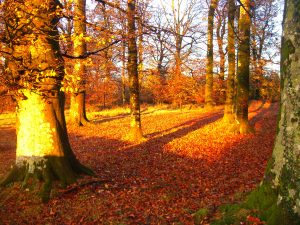The lime has got to be one of my favourite trees – not just for its tall leafy elegance, but for it’s multitude of uses in bushcraft. When I mention the lime tree on bushcraft courses people sometimes think I am referring to it’s exotic, citrus-bearing namesake! In reality, the small-leaved lime is native to Britain and was, in fact, one of the early colonisers after the last glacial retreat.
The scientific name Tilia cordata alludes to the cordage (string) that can be made from it’s inner bark fibres. Another name for the lime is “Linden tree” – derived from the old English word Linde which again means rope. In early summer I sometimes harvest a small branch, score and prise off a gutter-like length of bark. The bark is then left to soak in water for 2 weeks. This allows bacteria to break down the inner bark so it transforms from stiff “cardboard” to flexible layers of ribbons. Although a somewhat fetid process, once rinsed and dried the fibres acquire a pleasant, leathery fragrance! They make fantastic soft cordage – great for everything from fishing lines, bow drill strings and rope.

Lime cordage
At one point in my bushcraft career I was lucky enough to work in a woodland sprinkled with lime. I quickly discovered that the same bark fibres make great tinder (material that lights with a spark). If you can find a dead standing branch, snap it and pull off the bark and then work it with your hands you will soon have a fine mass of hair-like fibres. Even when wet, these fibres can be quickly wrung out and dried in a warm trouser pocket.
Lime timber is also known as “bass wood” – a material with some quite unique properties. It has a very low density, is soft, and has a low combustion point (easy to set fire). It makes for a great carving wood due to its softness and tendency to hold its form and not warp. In the past, lime boughs have even been hollowed out to make dug-out canoes! The wood also makes a great kindling, particularly feather sticks (shaved sticks used for firelighting) and an excellent fire by friction wood. In fact, it is possible to make up an entire bowdrill (fire by friction) set from the lime tree, including the bow string!
In the spring the newly emerged leaves make a good addition to a fresh leaf salad, with their beautiful heart-shapes. Later, in early summer the lime flowers drip nectar on unsuspecting cars! At this time the flowers can be collected and steeped to make a pleasant “Linden Tea”.
So the lime can provide you with a drink, food, great carving wood, a fire, and some string! If you have a lime in your woods you should indeed count yourself lucky!



